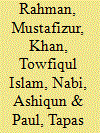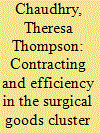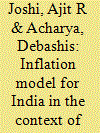|
|
|
Sort Order |
|
|
|
Items / Page
|
|
|
|
|
|
|
| Srl | Item |
| 1 |
ID:
103949


|
|
|
|
|
| Publication |
2011.
|
| Summary/Abstract |
This article investigates new opportunities that are emerging for Bangladesh with regard to her trade with India. In spite of the growing bilateral trade deficit, value of Bangladesh’s exports to India increased by about three times over the last five years. Examination of the dynamics of Bangladesh–India bilateral trade reveals that the number of products in Bangladesh’s export basket has registered significant increase, while at the same time, composition of the country’s exports to India has also shifted towards newer and non-traditional products. RCA analysis shows that export items with RCA > 1 in India, which include raw jute, chemical fertilizer, cement, RMG, leather, battery, textile fabrics and some other items, have significant export opportunities and have a combined potential market of US$ 2 billion in India. On the basis of examination of various tariff and nontariff barriers to trade with India, the article attempts to assess the economic implications of India’s sensitive list as it applies to Bangladesh, and argues that elimination of this list is not likely to have an adverse impact on India’s revenue earnings. The article also comes up with a number of recommendations to deal with the NTBs faced by Bangladesh in her trade with India, particularly in areas related to constraints arising from lack of trade facilitation.
|
|
|
|
|
|
|
|
|
|
|
|
|
|
|
|
| 2 |
ID:
103948


|
|
|
|
|
| Publication |
2011.
|
| Summary/Abstract |
This article provides empirical evidence of the inefficiency of contracting institutions (measured by high switching costs) among surgical instrument producers in Sialkot, Pakistan, even though it is an industrial cluster where manufacturers have access to a multiplicity of suppliers. Following the methodology of Johnson, McMillan and Woodruff (2002), we found that nearly 50 per cent of firms in the sample would reject an untried supplier offering a lower price. The decision to reject a prospective new supplier offering a 10 per cent discount was positively related to the complexity of the input and measures of relational contracting, and negatively related to a belief in informal contract enforcement mechanisms. Firms were more likely to switch to the prospective discount supplier when they were introduced through a business network. Belief in formal contract enforcement was not significant in any of the regressions.
|
|
|
|
|
|
|
|
|
|
|
|
|
|
|
|
| 3 |
ID:
103944


|
|
|
|
|
| Publication |
2011.
|
| Summary/Abstract |
This article investigates the exchange rate pass-through for Indian export and import prices. A markup model for aggregate export/import prices is set up, and the analysis is carried out using Johansen-Juselius cointegration and error correction models. The evidence shows partial pass-through into export prices, but more than complete pass-through into import prices, with the long-run pass-through coefficients being larger than the short-run coefficients. Thus, the Indian exporter does appear to have a little bargaining power, but it is not so with the Indian importer. The results cast a question mark over the efficacy of exchange rate changes as a policy tool in correcting trade balances, and also point to the risk of imported inflation.
|
|
|
|
|
|
|
|
|
|
|
|
|
|
|
|
| 4 |
ID:
103946


|
|
|
|
|
| Publication |
2011.
|
| Summary/Abstract |
In this article, an atheoretic model is built to explain and forecast inflation, using variables that capture domestic as well as foreign influences on inflation. In all, five specifications of models are estimated, one with only domestic variables and four with one of the foreign price variables, namely, Commodity Price Index (COMM), US Producer Price Index (USPPI), crude oil price (CRUDE), industrial countries' Consumer Price Index (CPI) (INDCPI). It is found that models with foreign price indicators provide better in-sample fit than the baseline model with only domestic variables. Among the models with foreign price variables, the Commodity Price Index (COMM) performs as the best foreign price variable among the set used, in terms of both in-sample and out-of-sample root mean squared errors (RMSE).
|
|
|
|
|
|
|
|
|
|
|
|
|
|
|
|
| 5 |
ID:
103947


|
|
|
|
|
| Publication |
2011.
|
| Summary/Abstract |
This article tests the validity of a Forward Discount Bias Puzzle, in a small open developing economy (SODE)-Sri Lanka-by employing first an unstructured vector autoregression (VAR) model and then a structured VAR model. The author argues that empirical examinations concerning SODEs cannot merely replicate methodology followed in testing developed economies, and identifies the need to disentangle capital flows from interest rate changes by including both capital flow and monetary policy variables. The article finds no evidence of a Forward Discount Bias Puzzle in Sri Lanka, and that perfect capital mobility is a too strong assumption. Hence, it proves that empirically more appropriate approach is to assume some capital mobility and incorporate capital flow data to accommodate for this change, in the analysis of UIRP.
|
|
|
|
|
|
|
|
|
|
|
|
|
|
|
|
| 6 |
ID:
103945


|
|
|
|
|
| Publication |
2011.
|
| Summary/Abstract |
Low household expenditure on education compromises the learning and future labour market prospects of children. This study provides an empirical framework for determining the criteria that South Asian policy-makers can use for assisting households with educational expenditure. A case study of urban Bangladesh using tobit and hurdle regression models indicate that households in the bottom two per capita quartiles should receive priority as recipients of policy assistance. Other criteria include households with parents who have not completed primary schooling and households with boys, older children and multiple children of school-going age.
|
|
|
|
|
|
|
|
|
|
|
|
|
|
|
|
|
|
|
|
|